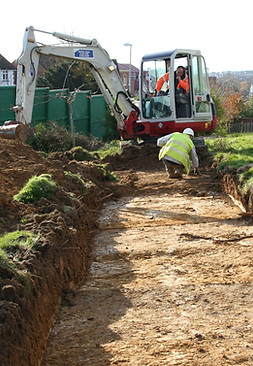Planning & Development
In 2012, the National Planning Policy Framework (NPPF) was introduced. This planning guidance set out the policies and principles for the conservation of the Historic Environment during planning and development.
Due to this, many planning applications now have archaeological conditions that need to be addressed before an application can be accepted.
CBAS offers a full range of services in compliance with the archaeological requirements of planning and development. For more details on what your application may entail, please take a look at our services below.
If you require further information about this process or would like a quote, please contact us.
Please include as much detail as possible in your enquiry.
Heritage Statement

Planning applications now require a Heritage Statement. This document is used to understand the potential impact of proposed works on potentially affected heritage assets. These must be prepared by someone with appropriate expertise and knowledge. These requirements are outlined in planning guidance PPS5.
For more information, please click here.
CBAS can produce Heritage Statements at the appropriate level, to accompany your planning application.
Our specialists have the necessary expertise, and access to a full range of resources, to assess the possible impact of proposed developments on heritage assets.
Desk-based Assessment

A full desk-based assessment (DBA) may be required if there is potential for the presence of heritage assets of archaeological interest. A DBA can be the first stage of the archaeological process and is often required at the beginning of a planning application.
A desk-based assessment shows research and analysis of the known and potential archaeology of a site and its immediate surroundings. It will include a critical look at any past impacts on the site, such as earlier development, to establish whether the proposed development is likely to damage or destroy any archaeology.
A DBA will require an inspection of the Historic Environment Records for the site and its immediate surroundings. Published archaeological reports and historical records will also be consulted, whilst any estate maps, tithe maps and Ordnance Survey maps will be inspected. If aerial photographs are available, these will also be consulted as they may often reveal buried features.
Lastly, a DBA will include a site visit. This is to establish whether there are any visible remains and to see the site in its landscape setting, aiding in any items that may be missed in the above searches.
CBAS has access to all the records required to undertake this research, either within our own library of national, regional and local sources, or through County Records Offices and Libraries. Our specialists produce high quality and thorough DBAs that meet the requirements of the planning authorities.
Evaluation

Often, the most effective way of establishing whether there is archaeology present on a development site is to excavate some evaluation trenches, sometimes alongside other exploratory techniques such as geophysics and fieldwalking.
The timescale of an evaluation is as follows. First, a Written Scheme of Investigation (WSI), required by the County Archaeologist, will be done on site by our archaeologists. Once this is approved, fieldwork can commence. Any artefacts recovered will then need to be processed and assessed before a results report is written and sent to the planning authority.
Evaluation trenches are normally excavated under archaeological supervision using a mechanical excavator with a flat-bladed bucket. Soil is removed until archaeological remains or the natural geology is reached. Any archaeological remains uncovered are sampled and recorded so that their character, dating and function can be determined. This will allow the County Archaeologist, who advises the planners, to determine if and what further mitigation work will be required prior to development commencing.
If further works are required, the importance of the remains found on site will decide how the planning will then proceed. If the finds are of high importance, a full excavation may be required, or a redesign of the development may be necessary so that the application is not refused. If the remains are of low importance, a watching brief may instead be required during the development, which can continue as planned (see below for details about both options).
Whether large or small scale, CBAS can undertake evaluation excavations efficiently and economically, providing quick results and advice on how to mitigate any archaeological remains discovered.
Watching Brief

A watching brief is used to monitor development work that is already underway.
A qualified archaeologist needs to be present on site during the groundworks. They will monitor the excavations to ensure any archaeological remains and artefacts are recorded. Due to the methodology employed, this may cause minor delays to the excavation, but we work with the groundworkers to ensure that delay is kept to a minimum.
A Written Scheme of Investigation (WSI), required by the County Archaeologist, will be completed on-site by our archaeologists. Once this is approved, the fieldwork can commence. Any artefacts recovered will need to be processed and assessed. Finally, a results report will be written and then sent to the planning authority.
CBAS has many years’ experience in providing watching briefs during development. We pride ourselves in working with on-site contractors to minimise delays and keep development moving as planned wherever possible.

Excavation
Occasionally, important archaeological remains may be revealed by preliminary work. Although this may not stop your development, the remains may need to be fully excavated and recorded before the development can commence.
The full scale of the excavation and what is required will need to be done on a site-by-site basis and discussed with the County Archaeologist.
CBAS has many years’ experience in developing and agreeing appropriate plans for excavations with the County Archaeologist. We pride ourselves in undertaking excavations that are cost-effective and time efficient so that the client’s developments can continue as planned.


